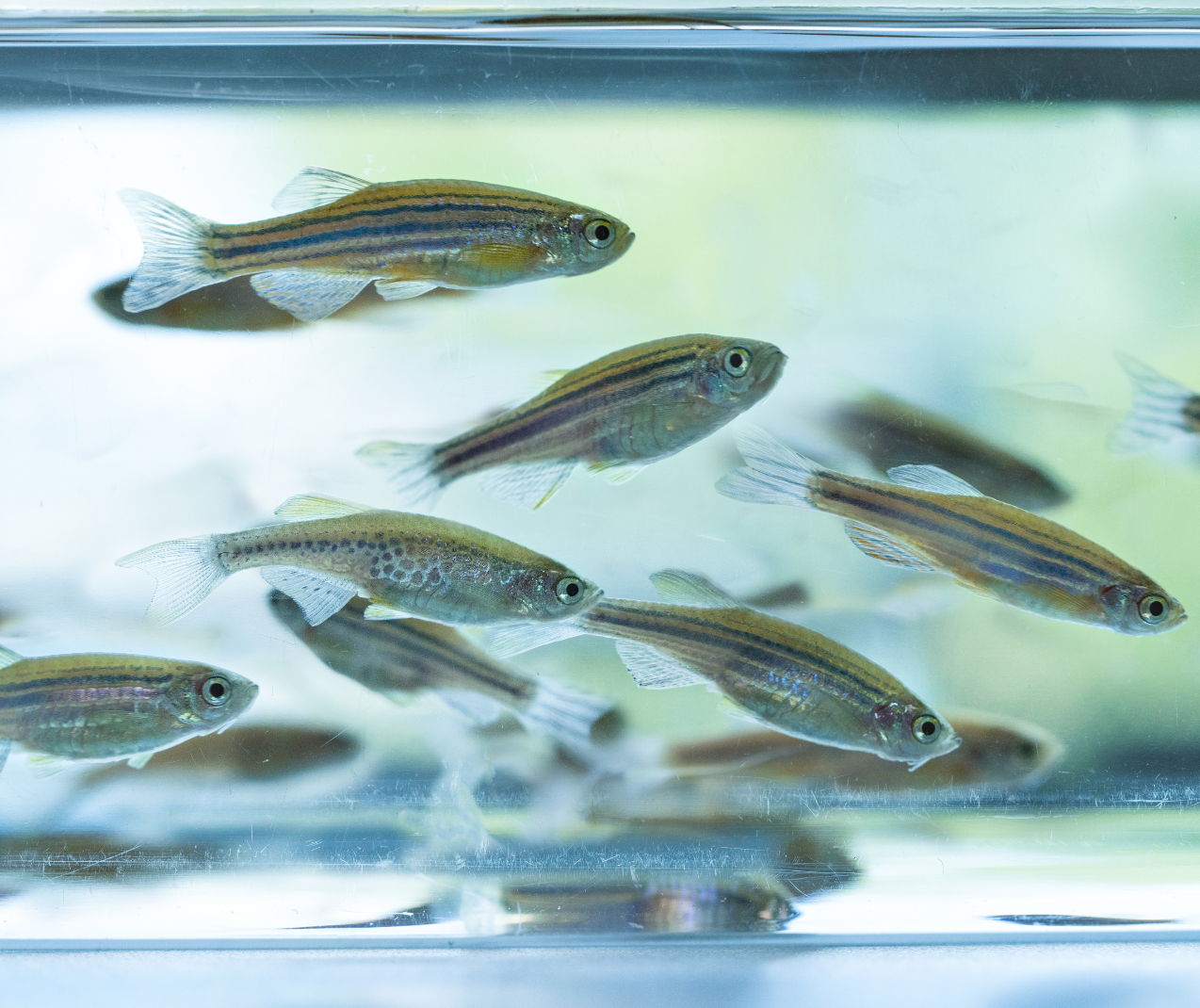Door Ilcim Ozlu
Wat de meeste biomedische wetenschappers motiveert is om zieke patiënten te helpen en bij te dragen aan nieuwe behandelingspistes. Ontwikkelingsbiologie—hoe organen en weefsels ontwikkelen—is van fundamenteel belang voor medisch onderzoek.
Als wetenschappers hebben we helaas nog steeds dieren nodig in ons onderzoek om te ontrafelen hoe het menselijk lichaam werkt. Ik heb in verschillende onderzoekslaboratoria gewerkt die muizen en zebravissen als experimentele modellen gebruiken om de basisprincipes van embryonale ontwikkeling te begrijpen.
Omdat ik altijd al geïnteresseerd was in de oorzaak van neurodegeneratieve ziekten, richtte mijn eerste project zich op de ontwikkeling van de hersenen. Door inzicht te krijgen in de ontwikkeling van een gezond brein en hoe unieke hersenstructuren samenwerken binnen dit complexe orgaan, kunnen we de oorzaak van ziektes die zich voordoen in een bepaald deel van de hersenen beter begrijpen.
Na een aantal jaar onderzoek naar hersenontwikkeling begon ik mijn doctoraat over de ontwikkeling van de lever en de vorming van galkanalen. De ontwikkeling en functie van de lever wordt bestudeerd in verschillende diermodellen, maar wij gebruiken voor ons onderzoek de zebravis. Dankzij de unieke manier waarop we zebraviscellen kunnen visualiseren, kunnen we een antwoord zoeken op de vraag: ‘hoe organiseren cellen zich tot kanaaltjes in de lever’?

De lever van een zebravislarve gekleurd
met een groen fluorescerend eiwit
Deze kanalen zijn essentieel voor de leverfunctie, omdat ze gal naar de darmen moeten transporteren. Ons laboratorium is geïnteresseerd in de Ephrine-eiwitfamilie, die eiwitten omvat die bij de meeste diersoorten—inclusief de mens—voorkomen. Hersenonderzoek toonde aan dat zenuwcellen hun juiste locatie vinden aan de hand van Ephrines. In ons labo ontdekten we dat Ephrines, net zoals in de hersenen, de cellen die kanaaltjes vormen in de lever gidsen. Wanneer dit gidssysteem verstoord is, kan dit tot galwegdefecten leiden, zoals we die bijvoorbeeld kennen bij mensen met het Alagillesyndroom.
Maar hoe hard lijken deze problemen bij de zebravis op ziekten bij de mens? Verrassend genoeg heeft deze kleine vis heel wat genetische gelijkenissen met ons. Tot 70% van al z’n genen zijn terug te vinden bij de mens en 84% van deze genen hebben ook een link met menselijke ziekten. Geen wonder dus dat de zebravis een zeer relevant diermodel is om de menselijke biologie te bestuderen. Er zijn natuurlijk diermodellen die genetisch nog dichter bij de mens staan, en die kunnen ingezet worden om resultaten uit zebravis verder te valideren, maar dat is technisch niet altijd mogelijk.

Tot 70% van alle zebravisgenen zijn terug te vinden bij de mens en 84% van deze genen hebben ook een link met menselijke ziekten.
Er zijn nog andere redenen waarom de zebravis een perfect model is voor het bestuderen van de embryonale ontwikkeling van organen. Zebravisembryo’s zijn namelijk transparant tijdens de vroegste stadia van hun ontwikkeling, wat handig is om cellen en organen in kaart te brengen. In andere zoogdiermodellen is het moeilijker om een dit soort dynamische processen te volgen, want de weefsels zijn niet doorzichtig. Bovendien kan één paar zebravissen tot 200 embryo’s tegelijkertijd voortbrengen. Bij de kweek hoeven we dus weinig volwassen vissen in te zetten, die uiteraard een hoger bewustzijn hebben dan embryo’s. Hoewel er heel wat voordelen zijn om de zebravis als diermodel te kiezen, is in werkelijkheid iedere dierproef afgestemd op de specifieke wetenschappelijke vraag.
Wanneer we dierproeven doen is het vooral belangrijk dat we de proefdieren waarderen en respecteren. Het is essentieel dat elke wetenschapper de 3R’s volgt—Vervanging, Vermindering en Verfijning—om het aantal dieren dat in elk experiment wordt gebruikt te minimaliseren. De proefdieren moeten volgens de hoogste normen worden verzorgd, zonder onnodig lijden. Sowieso omdat dit ethisch juist is, maar bovendien ook om optimale wetenschappelijke resultaten te bekomen.
Ilcim Ozlu, PhD student
Novo Nordisk Foundation for Stem Cell Biology
University of Copenhagen
De bijdrage van Ilcim werd vertaald uit het Engels. Hieronder vind je de originele tekst:
What can we learn from zebrafish to unravel human diseases?
I believe most scientists would agree that our day-to-day motivation is to help patients with devastating diseases and contribute to the search for new treatments. Developmental biology – how organs and tissues grow and form in the absence of disease – is fundamental to medical research. Because of many biological unknowns, as scientists, we need animals in our research to expand our knowledge of the complexity of human body and how it works. I have worked in different research labs that use mice and zebrafish as experimental models to understand the basics of embryonic development. As I was always interested in the development of neurodegenerative diseases, my first project focused on brain development. By understanding the development of a healthy brain and how its unique structures function within this complex organ, we can better understand the cause of a particular disease arising at a particular part of the brain.
After a few years of brain development research, I began my PhD project focusing on the formation of the liver and the biliary ducts in zebrafish. The development and function of the liver is broadly studied in various animal models. Yet, thanks to the methods that are available to image cells in zebrafish, we can try and answer the interesting question: ‘how do cells organize themselves to form tubes within the liver’? Tubes are essential to the liver’s function, as they are required to transport bile to the gut. As a lab we are interested in the protein family, Ephrins, which are present and function in most animal species including humans. Findings in the brain showed that neurons navigate to find their final position using Ephrins; this guidance system helps each neuronal cell to sense its neighbors via structures at their tips called axons. In our lab, we found that Ephrins, like in the brain, control the movement of ductal cells. When this guidance system is perturbed it affects the continuity of the bile ducts suggesting that impaired Ephrin function may lead to bile duct defects that we commonly observe in human diseases, such as Alagille syndrome.
What is the resemblance between the defects we see in zebrafish and those underlying human disease? Surprisingly, this small fish has a very high genetic similarity to humans. Up to 70% of all zebrafish genes are conserved in humans and 84% of these genes are known to be associated with human diseases, making zebrafish a highly relevant animal model in which to study human biology. Ideally, other cellular systems that are genetically even closer to man, will be used to validate and strengthen our conclusions, but this is not always technically possible.
There are more reasons why the zebrafish is a perfect vertebrate model for studying the embryonic development of many organs. Zebrafish embryos are transparent during the early stages of their development, which comes in handy when visualizing cellular behavior and organ growth in live animals. In other mammalian models, it is highly challenging to follow such a dynamic process due to tissue pigmentation which hinders the accessibility of many imaging technologies. In addition, a couple of zebrafish adults can produce up to 200 embryos from each breeding, thus we do not need to use many adult fish, that are arguably more sentinel, during our research. Whilst there are many advantages for choosing zebrafish as an animal system, in reality all animal research is tailored for its own scientific question.
Most importantly, while we are focused on our scientific aim, we must appreciate and respect the animals we use in our research. It is key that every scientist in animal-based research follows the 3R’s – Replacement, Reduction and Refinement – in order to minimize the number of animals used in each experiment. Those animals that are used must be cared for to the highest standard without any un-due suffering not only because it is ethically right thing to do, but also it yields the optimal scientific results.

